Second in a Series
In this series, Dr. Deb Bennett examines the equine hind limb. In this installment, Bennett explores the hock.
Farrier Takeaways
- Rapid flexion and extension of the joint during normal locomotion engenders friction between closely adjacent structures and between tendons and the underlying bone, necessitating the development of bursae.
- The compact structure of the hock means that many tendons must fit into a small area; some are even interwound or interlaced.
- Horses that are repeatedly asked to perform incorrect extensions of stride often develop cunean tendon irritation. Those with “post-legged” hindlimb conformation are also susceptible to chronic tenderness and swelling.
Weight-bearing upon flexed hocks puts enormous strain on all parts of the hock joint. Along with the equally complex stifle joint, the hock is crucial to the horse’s ability to flex and extend the hind limb and create the forward thrust that is the “impulsion” so often sought by horse owners who compete in the Olympic disciplines.
In the Western disciplines, the hock must stand up to sliding stops, rollbacks and bursting acceleration. Horses used for packing or trail riding must have hocks that will go all day, up and down steep hills, without rupture or fatigue.
The hock is structured by bones of peculiar shape. The tibial tarsal bone or astragalus upon whose oblique trochlea the distal end of the tibia rides also has a large shelf to support the deep digital flexor (DDF) tendon. The large fibular tarsal bone or calcaneus interlocks with the astragalus and has a projecting handle that serves to add leverage to tendons that attach to it. The fourth tarsal bone has a built-in canal that allows the internal passage of a large artery and vein. The other small bones of the hock have complex, interlocking shapes and are held together internally and to the top of the cannon bone and splints by short, stout ligaments.
The compact structure of the hock means that many tendons must fit into a small area; some are even interwound or interlaced (see below). Rapid flexion and extension of the joint during normal locomotion engenders friction between closely adjacent structures and between tendons and the underlying bone, necessitating the development of bursae, thickened areas of the skin and joint capsule and complex tendon sheaths.
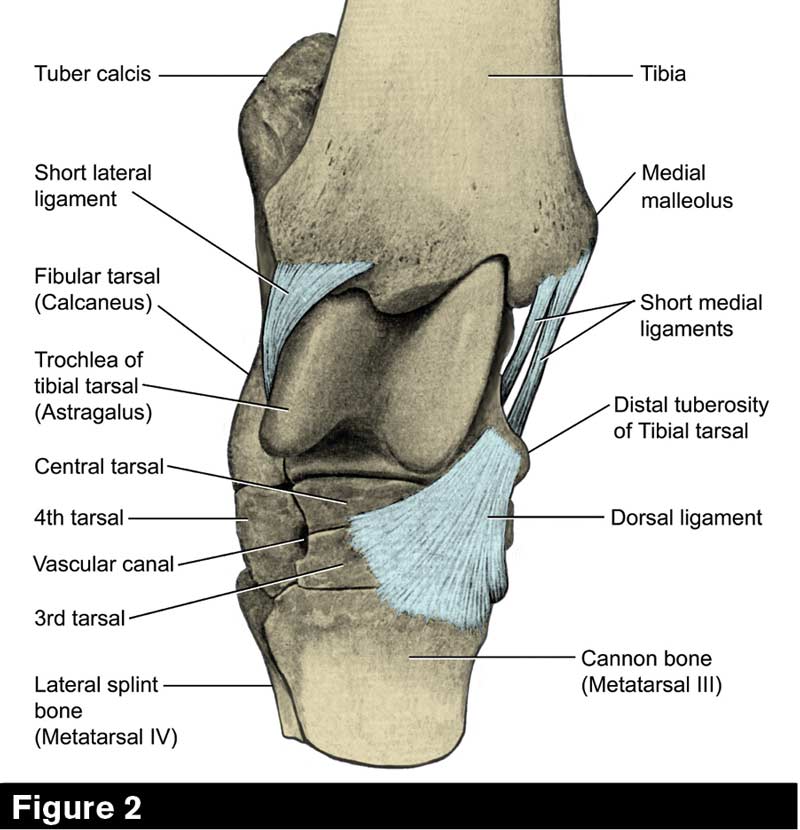
Anterior view of the bones and ligaments of the hock. This is a deep dissection; see other figures for more superficial structures. Note the oblique orientation of the trochleas of the tibial tarsal (astragalus). (Illustration based on the Dittrich original 1.)
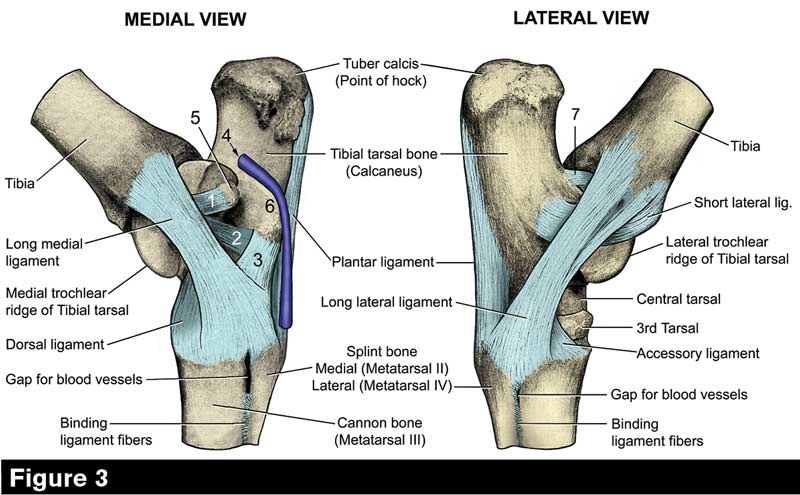
Medial and lateral views of the bones and ligaments of the hock. 1 and 2 = Branches of the short part of the medial ligament that binds the tibial and fibular tarsal bones. 3 = Tarso-metatarsal ligament that binds the fibular tarsal to the fourth tarsal and top of the cannon bone. 4 = Tendon of the deep digital flexor muscle, which plays over the smooth, saddle-shaped surface of the sustentaculum. It is protected by the tarsal sheath, a hose-like thickened membrane (dark blue). 5 = Proximal tuberosity of the tibial tarsal bone. 6 = Lateral edge of the sustentaculum. 7 = Short ligament that binds the fibular and tibial tarsal bones. (Illustration based on the Dittrich original 1.)
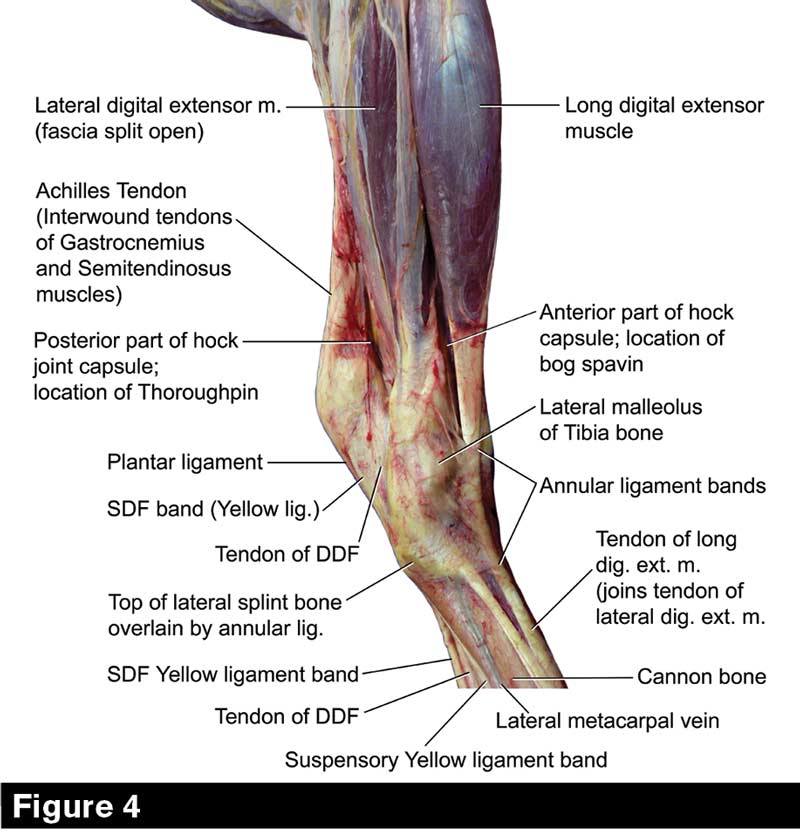
Dissection of a right hock in lateral view (from an Equine Studies Institute wet lab session).
The illustrations that accompany this survey walk you through many aspects of hock anatomy and function, including the study of human-horse homology (Figure 1); hock bone structure (Figures 2, 3, 6, 7, 11, 14, 15, 18); white ligaments (Figures 2-6, 7, 9, 14); yellow ligaments and muscles (Figures 4-7); joint capsules (Figures 4, 6, 7); tendon sheaths (Figures 3, 6-9); retinacula (Figure 9); bursae (Figures 6, 7, 9); extremes of conformation (Figure 10); and common pathologies and their specific locations (Figures 11-14).
Included are photographs of live horses that have pathologies characteristic of the hock. Extremes of conformation — post-leggedness and over-angulation or “sickle hock” (Figure 10) make hock strain and pathology more likely. Every farrier should be familiar with bone spavin, jack spavin, bog spavin, thoroughpin, capped hocks, curby hocks and cunean tendon irritation (Figures 11-13), because each has a different location and cause and therefore requires a different therapeutic approach.
The last five illustrations (Figures 15-18) teach topological anatomy (the relationship between the “lumps and bumps” that can be seen and felt on the outside and the bone and soft tissue structure within). In the horse and buggy era, before the advent of X-rays, topological anatomy was a major part of every veterinarian’s tool kit. Now that injections of the hock joints have become fashionable, topology is once again being taught. These illustrations can be used as a guide to practice palpating your horses.
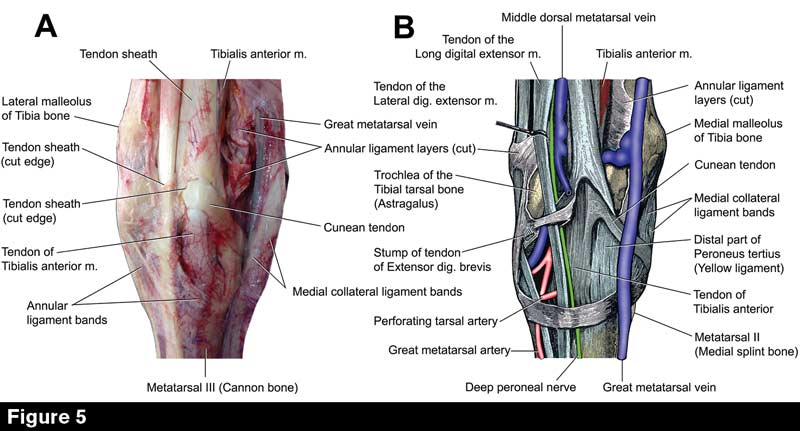
Closeup images of the hock in anterior view. A is “reality,” a photograph of a dissection carried out in my wet lab. B is the “road map,” an illustration from Schmaltz’ 1904 anatomy2.The interlacing of the cunean tendon, peroneus tertius yellow ligament band and main tendon of insertion of the tibialis anterior muscle are the most important features. The photograph brings out details of the annular ligament wrappings and fine blood vessels, while the illustration presents an idealized view of “what the student ought to be able to find” in terms of blood vessels and nerves which are never so plainly visible in an actual dissection.
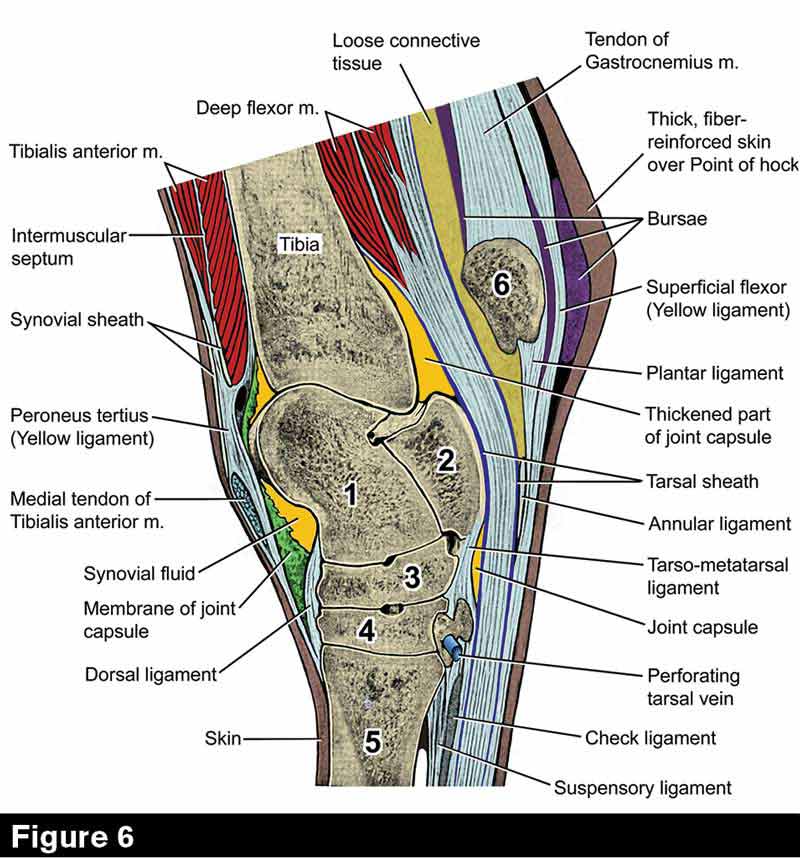
Vertical section cut through the midline of the hock joint. In section preparations, structures that have a lot of depth or curvature will appear to pop in and out of view, for example, the fibular tarsal bone, of which both 2 and 6 are parts. Likewise, the splint bone does not show in this cut because it is too far above the midline plane of the limb. When studying sections, it is important to remember that the living anatomy is three-dimensional. Visualize the annular ligaments, tarsal sheath, synovial sheaths and joint capsule as three-dimensional structures that wrap around the bones and ligaments of the hock joint. (Illustration based on the Dittrich original1.)
The main feature to study here is the relationship between the joint capsule, the sustentaculum, the tarsal sheath and the tendon of insertion of the deep digital flexor muscle. The bursae (purple) are also important. 1 = Tibial tarsal bone (astragalus). 2 = Base of fibular tarsal bone (calcaneus). 3 = Central tarsal bone. 4 = 3rd tarsal bone. 5 = Metatarsal III (cannon bone). 6 = Tuber calcis. The perforating tarsal vein passes through a canal in the fourth tarsal bone. Other gaps between tarsal bones provide anchorage for short, strong internal ligaments that bind the small bones of the hock together, and for small vessels. The tarso-metatarsal ligament is intimately adherent to the joint capsule. See Figure 5 for the complex relationship between the medial tendon of the tibialis anterior muscle and the peroneus tertius yellow ligament. The edges of the membrane of the anterior parts of the joint capsule appear ragged because they are as thin as the wall of a balloon that was torn during the process of sawing the limb in half. The tarsal sheath is the thickened outer layer of the tendon of insertion of the deep digital flexor muscle, which plays over the sustentaculum and the thickened posterior portion of the joint capsule. See Figure 9 for 3D views of the tarsal sheath.
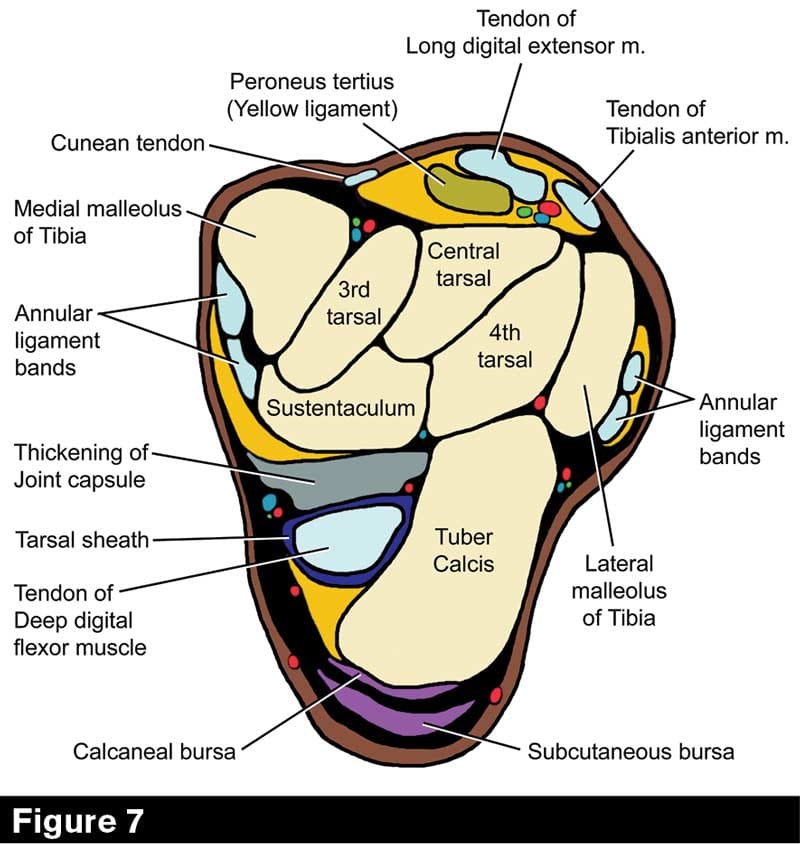
Cross-section through the hock joint, cut horizontally at a level near the upper surface of the central tarsal bone. This view clarifies the relationship of the tendon of the deep digital flexor muscle, tarsal sheath and thickened joint capsule. Note also the distribution of superficial and deep blood vessels and nerves and the position of the calcaneal and subcutaneous bursae (after Delling et al., 2013 3.)
Interlaced Tendons
Interlaced tendons feature in the lower part of the horse’s limbs, as the familiar “flexor perforatus-flexor perforans” relationship of the superficial digital flexor (SDF) and DDF tendons, in which the SDF tendon wraps around the DDF, forming a tunnel for passage of the latter.
Likewise in the hock, the distal part of the peroneus tertius band passes through a short tunnel formed by a Y-shaped fork in the tendon of insertion of the tibialis anterior muscle (Figure 5).
The oblique side branch of the tibialis anterior tendon that forms the medial part of the fork is called the cunean tendon. Lying on the anterior aspect of the joint at a point where pressure is focused upon it when the hock is opened wide, it is underlain by a bursa that acts as both a heat sink and as padding.
Horses that are repeatedly asked to perform incorrect extensions of stride, which force wider than the normal opening of the hock joint, often develop cunean tendon irritation. Those with “post-legged” hindlimb conformation are also susceptible to chronic tenderness and swelling there (Figure 10). Long-standing inflammation of the cunean tendon can provoke exostosis (deposition of coarse bony material) that horsemen refer to as “jack spavin” (Figures 11-13).
Tendon Sheaths, Joint Capsules and Bursae
Tendon sheaths are double-walled structures that facilitate the near-frictionless movement of tendons (see Figure 8 to learn a good way to conceptualize tendon sheath structure).
The typical tendon sheath membrane is no thicker than a balloon or the finger of an exam glove. The DDF and SDF tendons below the hock and knee are enwrapped by joint capsules that have a simple, linear shape. Sheaths curve and branch and most are also interconnected at a deep level so that the synovial fluid pressure inside them remains constant through all phases of flexion and extension.
Uniquely in the hock, the DDF tendon is encased in a tube with thick, tough walls. This structure, called the tarsal sheath, develops where the DDF tendon plays over the smooth, saddle-shaped surface of the sustentaculum tali (a bony shelf on the medial aspect of the fibular tarsal bone). If tendon sheaths can be likened to balloons, then the tarsal sheath can be likened to a garden hose (Figures 3, 6, 7).
Joint capsules are single-walled, balloon-like elastic sacs that secrete and contain synovium (lubricating joint fluid).
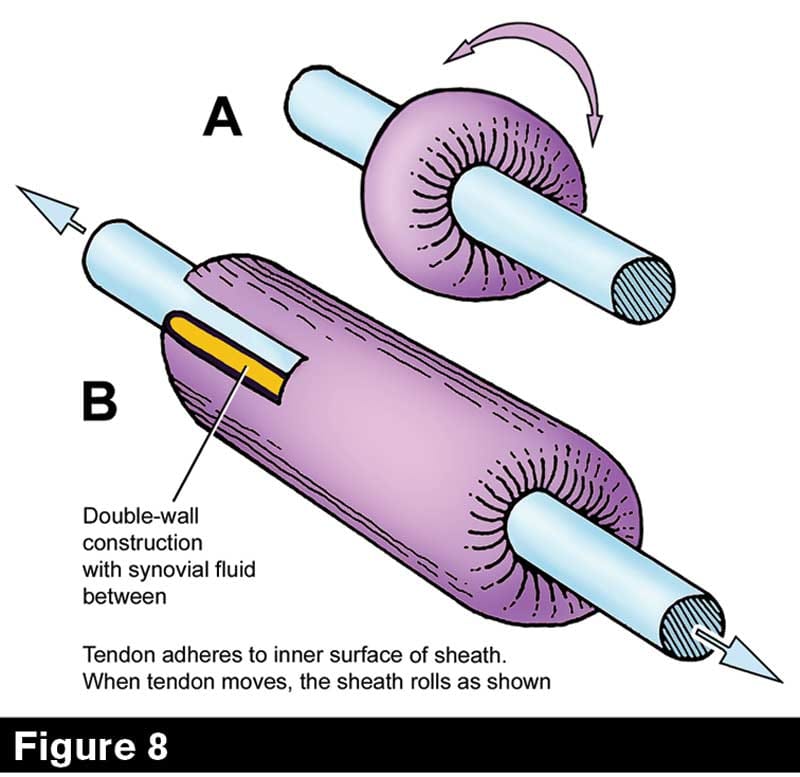
The structure of a tendon sheath is shown in (B). Please note, this is a “concept” illustration to aid in understanding the structure of tendon sheaths. Imagine a cable (blue) that runs through an inner tube (pink) as in view (A). The cable is coated with Velcro and the inner surface of the inner tube is too so that if the cable is pulled, the inner tube will “roll” (curved arrow). Now in your mind’s eye, elongate the inner tube into a hot-dog shape — this is the basic shape of a real tendon sheath. The cut portion shows the double-walled structure and the filling of synovial fluid. As the tendon plays back and forth, the sheath rolls on the inner lubrication, providing for nearly friction-free movement.
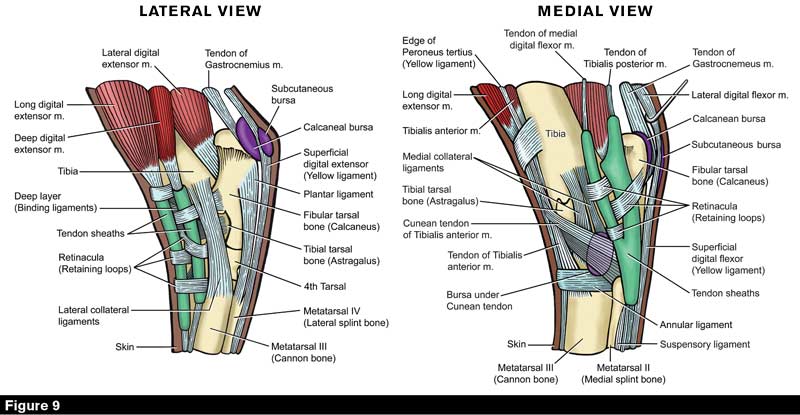
The hock joint in lateral and medial views. These are necessary “road maps” or idealizations. Note the retinacula, strong short bands developed within different layers of the annular ligaments. They function to keep the various long tendons in place even if the hock joint is sharply flexed under conditions of great force. Also highlighted are the tendon sheaths (green) which facilitate the up-and-down play of various long tendons of insertion. Note how the calcaneal and subcutaneous bursae are sandwiched between tendons and the skin, as is the bursa that lies under the cunean tendon. The superficial digital flexor band, like the peroneus tertius, is a yellow ligament (after the Dittrich original1).
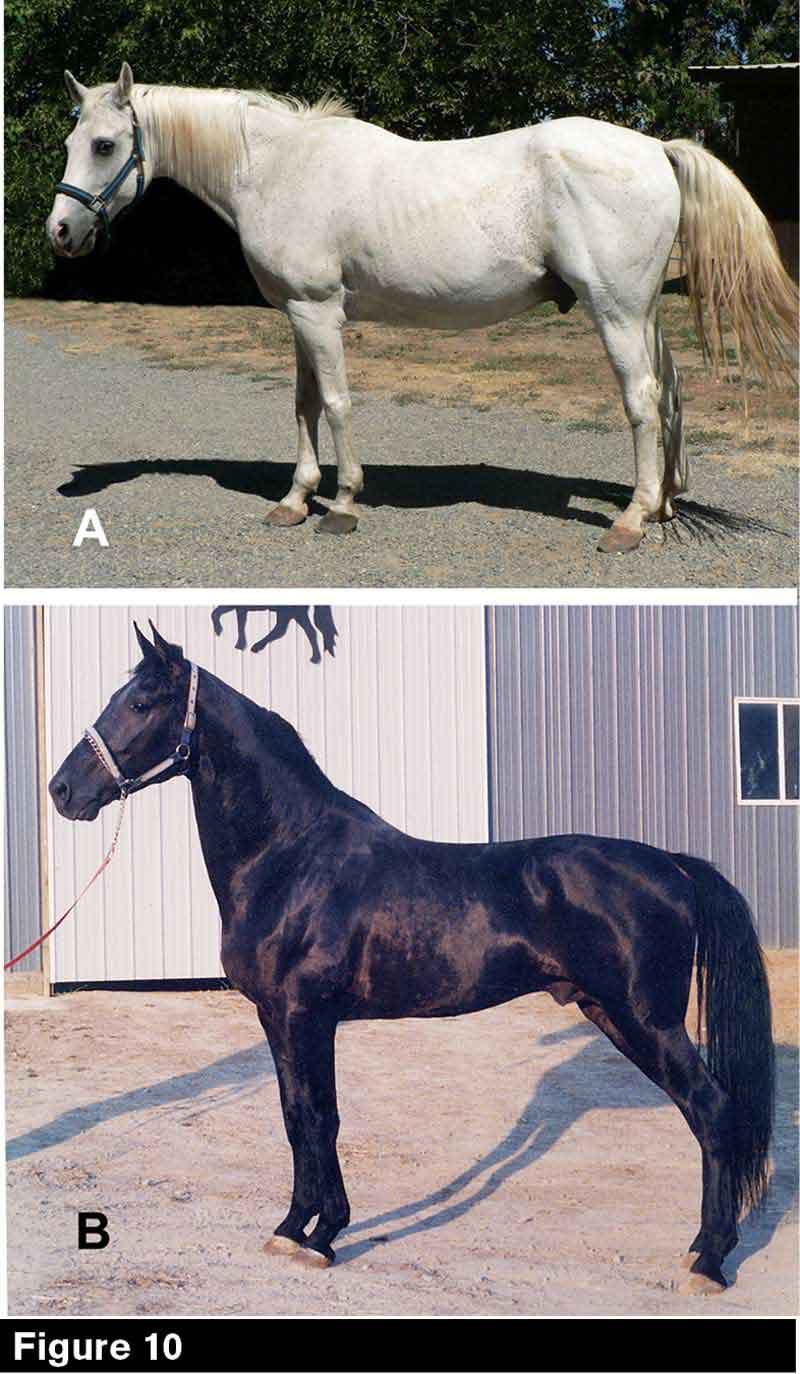
Horses with “extremes” of hind limb conformation are more likely to suffer from hock-related lamenesses. Conformation faults give rise to altered limb swing, hoof strike and breakover. A: An aged Arabian gelding with post-legged hindlimb conformation, which predisposes to stifle locking during movement (to be discussed in our next installment), as well as to cunean tendon irritation and pathology. B: A 5-year-old Tennessee Walking Horse stallion showing the opposite extreme. Over-angulation of the hind limb, sometimes called “sickle hock,” predisposes to curby hock and various types of spavin.
The hock joint manifests four capsules, the largest for the joint between the tibia and the tibial tarsal bone. The second sac lines the joints formed by the tibial and fibular tarsal bones above and the central and fourth tarsal bones below. The third pertains to the central and third tarsal and the fourth to the third tarsal and the top of the cannon bone and splints. All these sacs communicate interiorly so that injury or distension to one affects all of them.
The tibiotarsal sac is the largest because that is the only joint in the hock that is designed to make much movement. “Bog spavin” is edema (fluid buildup) in this joint capsule (Figures 4, 6, 13b). As protection against the extreme forces experienced by the tendon of the DDF where the tarsal sheath plays over the tibiotarsal joint capsule, the external capsular wall is greatly thickened. This is a design that occurs nowhere else in the equine body (Figures 6, 7).
Like tendon sheaths, bursae are also double-walled, but if the tendon sheath can be likened to a balloon and the tarsal sheath to a garden hose, then bursae are tractor tires — their walls made of much tougher and thicker fibrocartilage (Figures 6, 7, 9). Bursae are shaped like flattened pillows. Some have gel centers, others are fibrocartilagenous all the way through.
Bursae develop under any tendon in the body that attaches to, or overpasses, a joint that sharply flexes. They also develop where movement tends to force a tendon down against the bone that underlies it. Bursae develop variably; in young horses, the subcutaneous bursa may be represented only by thickened skin.
In jumpers or field hunters that have been at their game for years, the subcutaneous and calcaneal bursae that cap the point of hock thicken and toughen and can become confluent. “Capped hock” is edema that results from irritation of these bursae (Figure 13c). Curby hock, by contrast, has nothing to do with the bursae but arises from perinatal displacement and subsequent misalignment of the small bones of the hock and consequent strain of the plantar ligament (Figure 14).
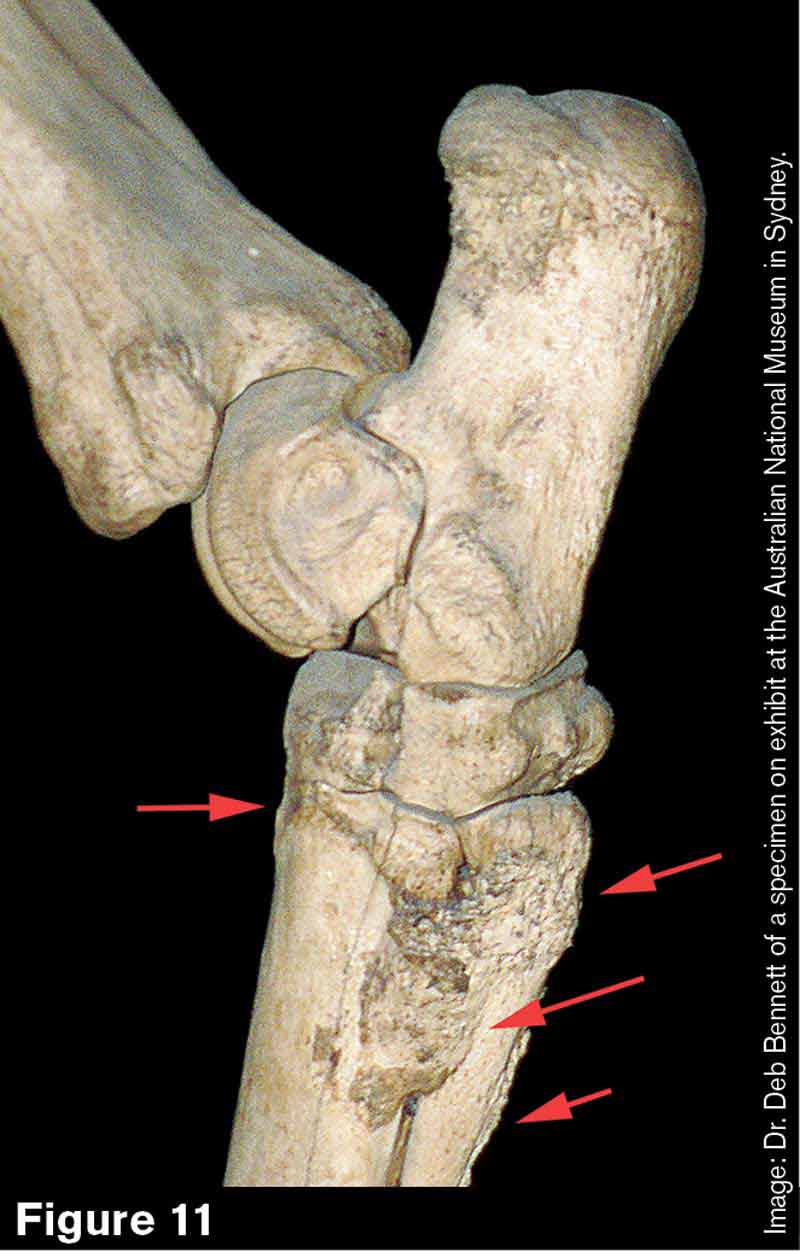
Bones of left hock in lateral view. Red arrows show areas of exostosis (abnormal deposition of coarse, rough bone), any and all of which may be called “bone spavin.” This specimen is a skeletal mount of an aged Thoroughbred gelding.
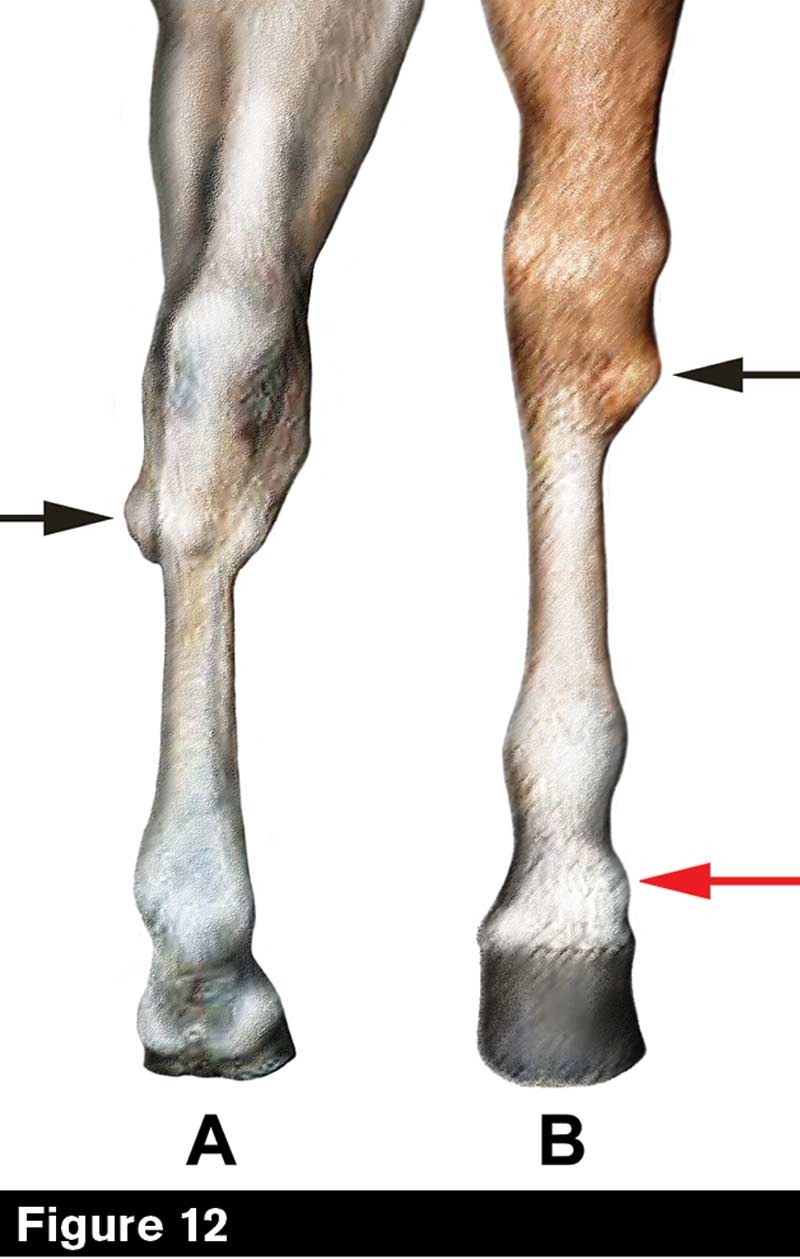
Various manifestations of “bone spavin” in the hocks of living horses. Unlike horses with curbs, capped hocks or bogs, spavined horses are often sore and lame. A: Rear view of the left hind leg showing exostotic enlargement of the junction between the fourth tarsal bone and the top of the lateral splint bone. B: Front view of the right hind leg of a different horse, showing exostotic enlargement of the lower tubercle of the tibial tarsal bone and the central tarsal bone. The red arrow shows an exostotic enlargement of the collateral ligament that binds the long and short pastern bones. Below it is a contracted hoof showing ringbone and a medial wall flare. This is a chicken-and-egg situation; it would be difficult to say which came first — the hock pathologies or those of the more distal limb.
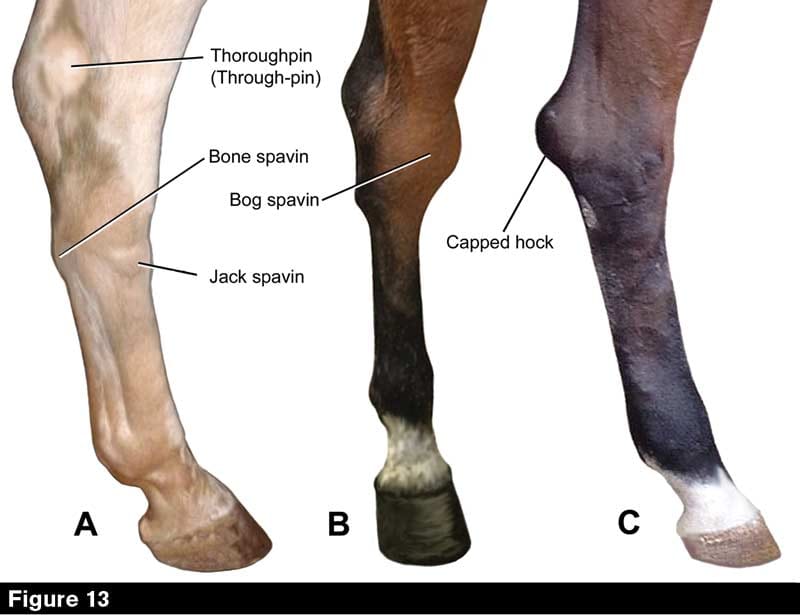
Pathological lumps and swellings. A: Lateral view of a right hind limb. B: Antero-lateral view of a right hind limb. Capped hocks (C, medial view of left hind limb) are sometimes the result of strain, as from jumping, but much more often are seen in horses that habitually kick the walls of the stall. The enlargement is the result of irritation and subsequent fluid build-up in the subcutaneous and calcaneal bursae. Self-quiz: what is the anatomical origin of each pathology? Which are likely to make the horse chronically lame? Which may feel hot, and which usually feel cool? Which feel soft and which are hard? Which are likely to resolve over time?
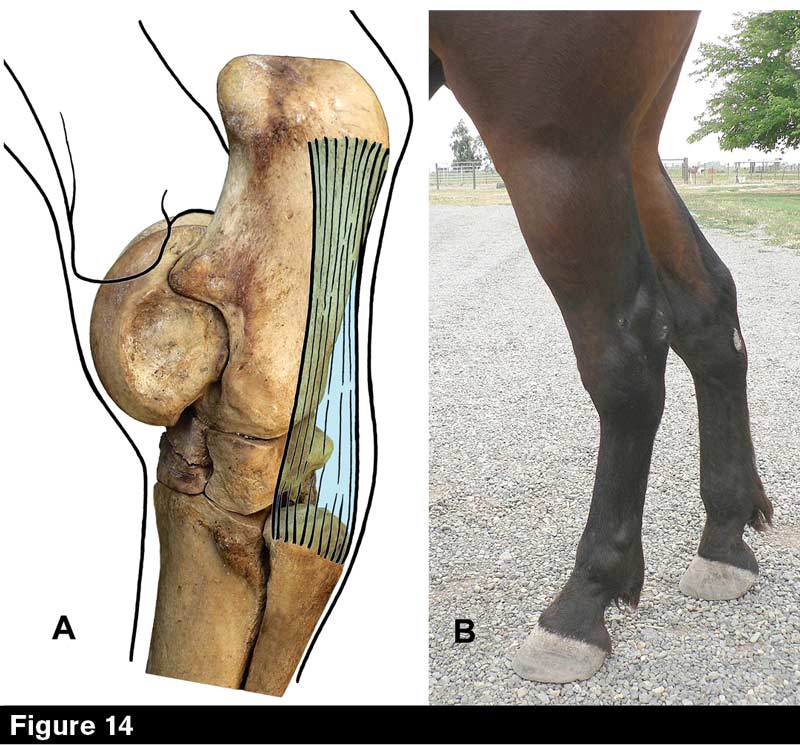
Curby hock is the result of rearward displacement of the small bones of the hock and the cannon bone and splints relative to the tibial and fibular tarsal bones (view A; compare this closeup of the hock bones with Figure 11). This in turn forces backward displacement of the plantar ligament (shown in blue), creating a bulge in the rear contour of the hock and a “cut out” contour in front (view B). This structural defect is never, in my experience, the result of strain due to athletic effort but rather develops during perinatal life, either just before or just after birth when the ligaments that bind the hock bones in place are still soft and rubbery. A strain of the plantar ligament itself, without bony displacement, is the result of athletic effort. It also produces a bulge on the back of the hock.
Yellow vs. White Ligaments
Yellow ligaments invest and surround both the stifle and hock joints and they are the essential components of the reciprocating system of the hind limb.
The origin and nature of yellow ligament tissue were covered in detail in our previous series on forelimb function (see American Farriers Journal September/October 2019, pp. 62-71), but just as a quick reminder, I use the term “yellow ligament” specifically to designate muscle tissue in which red, contractile cells do not develop.
Yellow ligament tissue is easy to distinguish, both chemically and histologically, from “white” or ordinary ligament tissue. Whereas white ligament is thin, tough, inelastic, coarsely fibrous and strong, especially when pulled parallel to the fiber direction, yellow ligaments are thicker in texture, less fibrous and strong and variably stretchy.
Although both tissue types are referred to as “ligaments” in conventional textbooks, they are different in every way. It is useful for farriers, as well as horse owners, to learn which ligaments are white and which yellow.
Collateral and annular ligaments belong to the white category, while the suspensory apparatus in all four limbs is the classic example of the yellow category. Confusingly, standard textbooks refer to the peroneus tertius and superficial digital flexor bands of the hind limb as “muscles.” They were indeed muscles in the horse’s fossil ancestors, but in living members of the genus Equus they develop few or no red contractile cells and function solely as thick elastic bands. In other words, they are yellow ligaments.
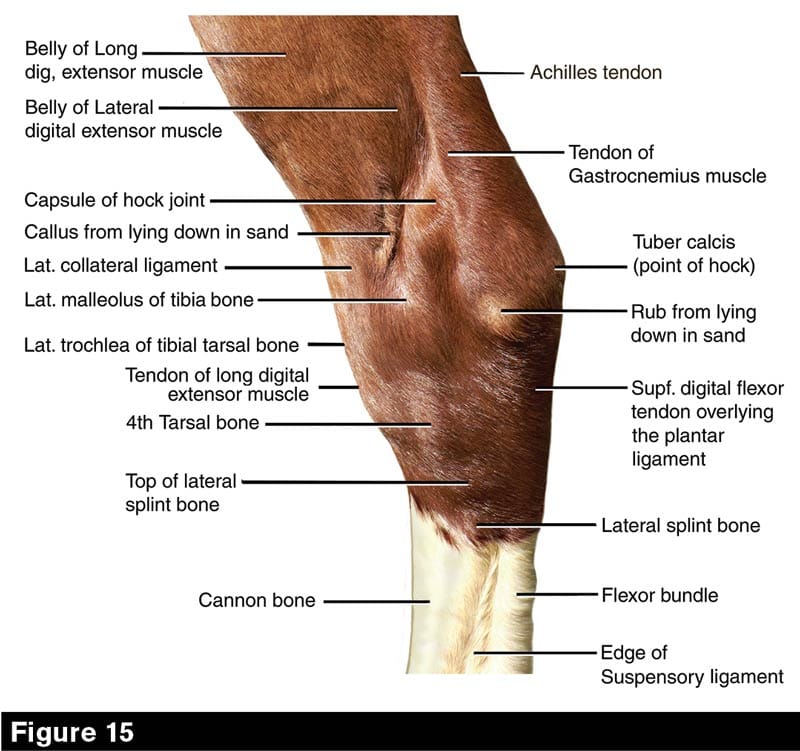
Practicum and self-quiz, part 1: the hock in postero-lateral view. Learning the topological anatomy of the hock is easier when you know the underlying bone structure. Palpate with your fingertips, then compare with Figure 16.
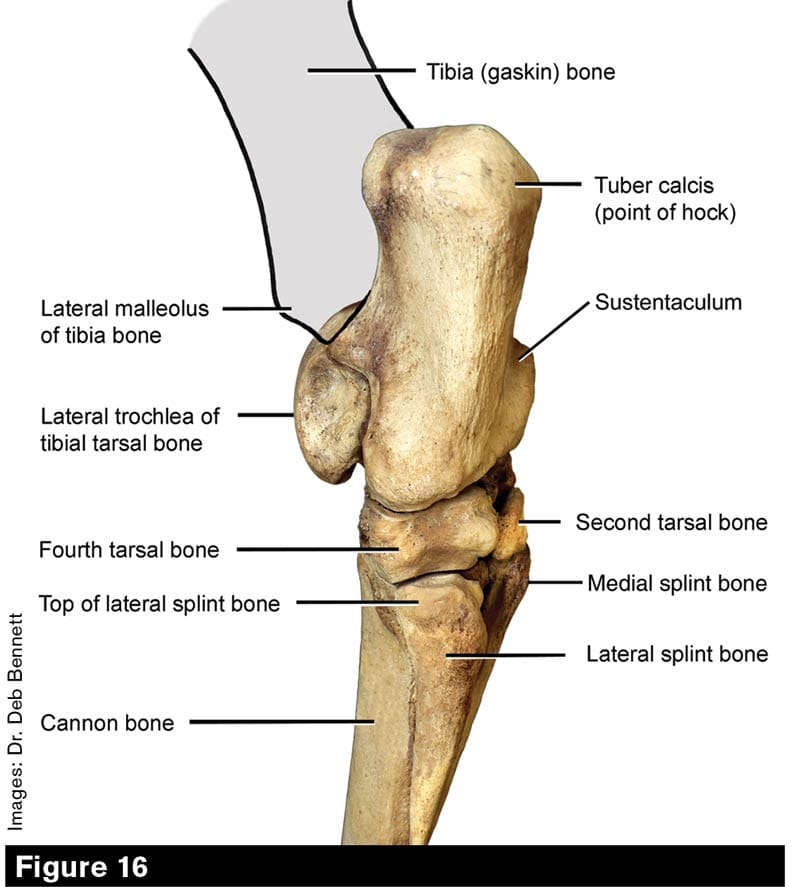
Hock bones in postero-lateral view. Compare with Figure 15.
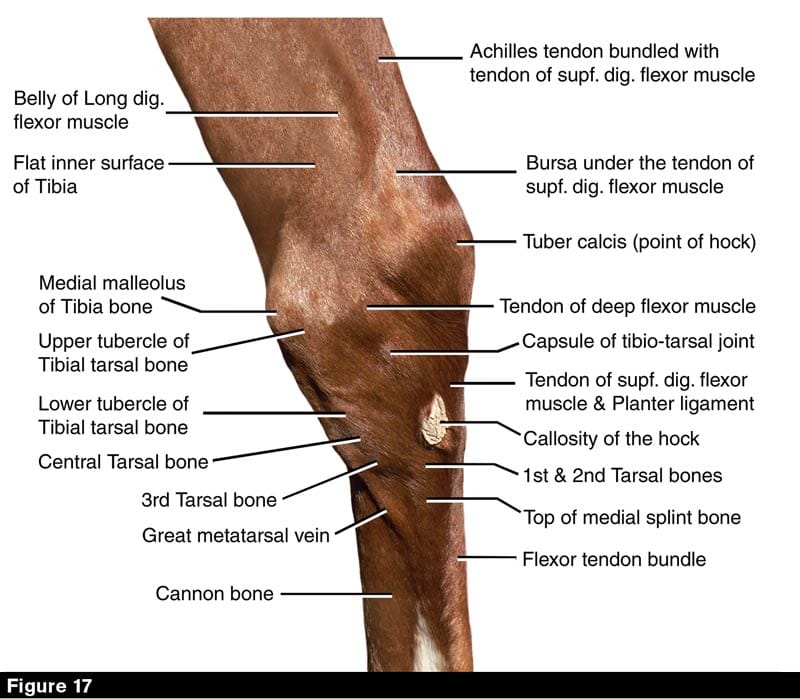
Practicum and self-quiz, part 2: the hock in postero-medial view. Palpate with your fingertips, then compare with Figure 18.
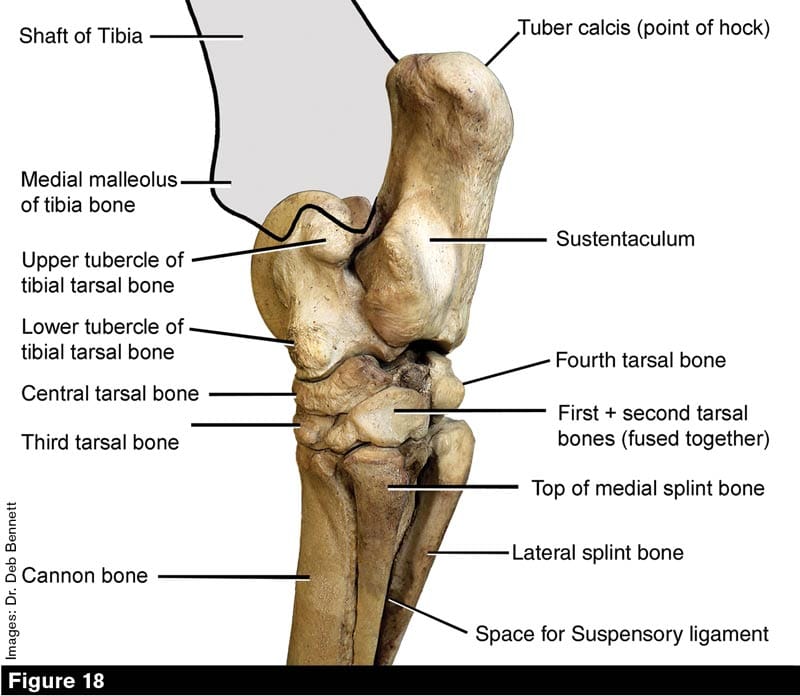
Hock bones in postero-medial view. Compare with Figure 17.
Answers to Self-quiz Questions in Figure 14
Jack and “bone” spavins involve ossification and exostosis at the insertions of binding and collateral ligaments. Jack spavin is the name used when the pathology arises on the anterior aspect of the hock. Bog spavin is fluid distension of the anterior compartment of the tibiotarsal joint capsule. Thoroughpin is fluid distension of the posterior compartment of that capsule. Capped hocks arise from irritation, inflammation and fluid accumulation in the subcutaneous and/or the calcaneal bursae. The hard spavins that involve exostosis often make the horse lame and at times will feel hot. Bogs and caps, which involve fluid distension and feel soft and cold to the touch, generally do not make the horse lame. Once established, none of these conditions usually return to normal. Hard spavins involving the splint bones are the most likely to completely resolve, especially if hoof imbalances are appropriately addressed.
References
- Ellenberger W, Baum H and Dittrich H. 1901. Handbuch der Anatomie der Tiere für Kunstler. Weicher T, Leipzig (English translation by Helene Weinbaum reprinted 1949 and subsequently by Dover Publications, New York).
- Schmaltz R. 1911. Atlas der Anatomie der Pferdes. Verlagsbuchhandlung von Richard Schoetz, Berlin. (The 1939 edition of this wonderful old manual is freely downloadable from the Utrecht University Library at http://hdl.handle.net/1874/35350).
- Delling U, Huth N, Stiller J, Mulling C , Scharner D and Brehm, W. 2013. Erkrankung der Tarsalbeugesehnenscheide (“Pathologies of the Hock”). Pferdeheilkunde 29(2013): 43-53. Weicher T, Leipzig (English translation by Helene Weinbaum reprinted 1949 and subsequently by Dover Publications, New York).

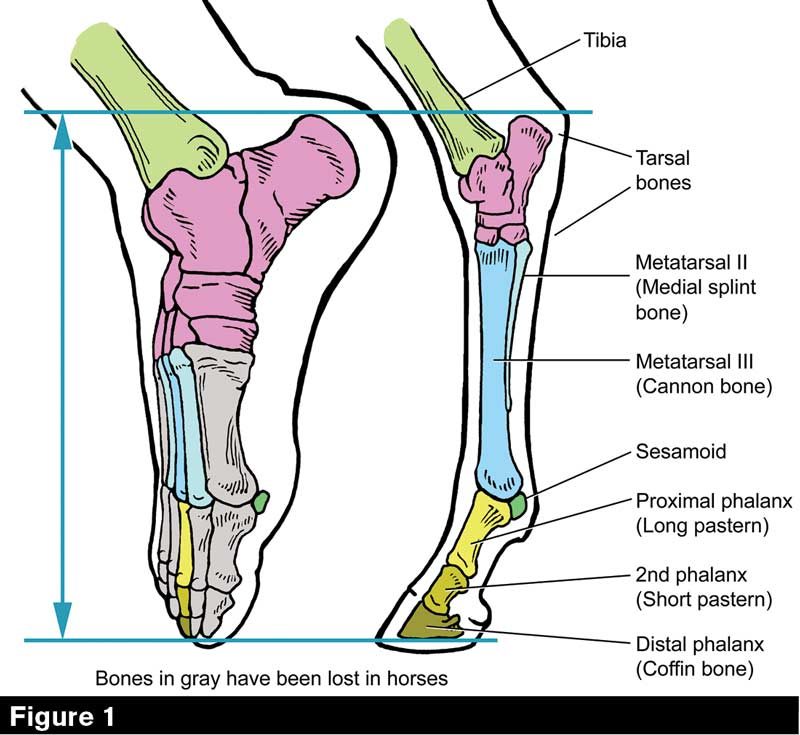
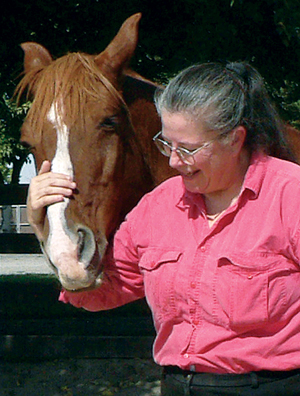






Post a comment
Report Abusive Comment